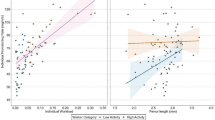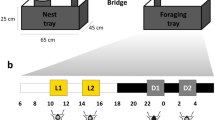Abstract
The moment-to-moment tasks performed by an individual can change in response to a shift of internal, e.g. body size or age, and external conditions, e.g. the number of workers currently engaged in another task. For this reason, the term “task allocation” is replacing the earlier concept of “division of labor” for describing an invariable association between worker body size and task. In the present study we hypothesized that, in the absence of changing conditions, different sized workers tend to perform different tasks. We also evaluated, using baits, the ability of colonies to regulate foraging activity through interactions between outgoing and returning foragers and the effect of ground temperature on the relative participation of different-sized workers to the foraging activity. Results suggest the existence in large and well-established colonies inhabiting a typical Mediterranean grassland area, of different-sized workers performing different tasks outside the nests. Moreover, we noticed the ability of colonies to adjust the relative participation of different sized foragers when provided with different-sized resources (baits). Finally, we recorded an effect of temperature on the average size of foragers, although no effect on size distribution was found.




Similar content being viewed by others
References
Bernadou A, Felden A, Moreau M, et al (2016) Ergonomics of load transport in the seed harvesting ant Messor barbarus Linnæus, 1767: morphology influences transportation method and efficiency. J Exp Biol jeb-141556
Breslow N (1970) A generalized Kruskal-Wallis test for comparing K samples subject to unequal patterns of censorship. Biometrika 57:579–594
Brown MB, Forsythe AB (1974) The small sample behavior of some statistics which test the equality of several means. Technometrics 16:129–132
Calabi P (1988) Behavioral flexibility in Hymenoptera: a re-examination of the concept of caste. In: Trager JC (ed) Advances in Myrmecology. E. J. Brill Press, Leiden, pp 237–258
Castracani C, Grasso DA, Fanfani A, Mori A (2010) The ant fauna of Castelporziano presidential reserve (Rome, Italy) as a model for the analysis of ant community structure in relation to environmental variation in Mediterranean ecosystems. J Insect Conserv 14:585–594
Clémencet J, Cournault L, Odent A, Doums C (2010) Worker thermal tolerance in the thermophilic ant Cataglyphis cursor (Hymenoptera, Formicidae). Insect Soc 57:11–15
Davidson DW (1977) Foraging ecology and community organization in desert seed-eating ants. Ecology 58:725–737
Dowgiallo G, Biondi FA (2001) I suoli. Accad Naz delle Sci Sist Ambient della Tenuta Pres di Castelporziano. Scritti e Doc XXVI(2):458–467
Dunn OJ (1961) Multiple comparisons among means. J Am Stat Assoc 56:52–64
Fanelli G (1998) Dasypyrum villosum vegetation in the territory of Rome. Rend Fis Acc Lincei 9:149–170
Ferster B, Traniello JFA (1995) Polymorphism and foraging behavior in Pogonomyrmex badius (Hymenoptera: Formicidae): worker size, foraging distance, and load size associations. Environ Entomol 24:673–678
Gordon DM (1987) Group-level dynamics in harvester ants: young colonies and the role of patrolling. Anim Behav 35:833–843
Gordon DM (1989a) Caste and change in social insects. Oxf Surv Evol Biol 6:55–72
Gordon DM (1989b) Dynamics of task switching in harvester ants. Anim Behav 38:194–204
Gordon DM (1996) The organization of work in social insect colonies. Nature 380:121–124
Gordon DM (2010) Ant encounters: interaction networks and Colony behavior: interaction networks and Colony behavior. Princeton University Press
Gordon DM (2016) From division of labor to the collective behavior of social insects. Behav Ecol Sociobiol 70:1101–1108
Grasso DA, Mori A, Le Moli F (1999) Recruitment and trail communication in two species of Messor ants (Hymenoptera, Formicidae). Ital J Zool 66:373–378
Grasso DA, Mori A, Le Moli F (2002) Behavioural investigation of trail signals specificity in three sympatric species of Messor ants (Hymenoptera, Formicidae). Ital J Zool 69:147–151
Heredia A, Detrain C (2005) Influence of seed size and seed nature on recruitment in the polymorphic harvester ant Messor barbarus. Behav Process 70:289–300
Hintze JL, Nelson RD (1998) Violin plots: a box plot-density trace synergism. Am Stat 52:181–184
Hölldobler B (1976) Recruitment behavior, home range orientation and territoriality in harvester ants, Pogonomyrmex. Behav Ecol Sociobiol 1:3–44
Huang Z-Y, Plettner E, Robinson GE (1998) Effects of social environment and worker mandibular glands on endocrine-mediated behavioral development in honey bees. J Comp Physiol A 183:143–152
Jeanne RL (1986) The organization of work in Polybia occidentalis: costs and benefits of specialization in a social wasp. Behav Ecol Sociobiol 19:333–341
Kaspari M (1996) Worker size and seed size selection by harvester ants in a Neotropical forest. Oecologia 105:397–404
Lopez F, Acosta FJ, Serrano JM (1994) Guerilla vs. phalanx strategies of resource capture: growth and structural plasticity in the trunk trail system of the harvester ant Messor barbarus. J Anim Ecol 63:127–138
Morehead SA, Feener DH Jr (1998) Foraging behavior and morphology: seed selection in the harvester ant genus, Pogonomyrmex. Oecologia 114:548–555
Oakley KP, Campbell BG, Molleson TI (1975) Catalogue of fossil hominids. British Museum (Natural History)
Oster GF, Wilson EO (1978) Caste and ecology in the social insects. Princeton University Press
Pacala SW, Gordon DM, Godfray HCJ (1996) Effects of social group size on information transfer and task allocation. Evol Ecol 10:127–165
Pirk GI, De Casenave JL (2010) Influence of seed size on feeding preferences and diet composition of three sympatric harvester ants in the Central Monte Desert, Argentina. Ecol Res 25:439–445
Prabhakar B, Dektar KN, Gordon DM (2012) The regulation of ant colony foraging activity without spatial information. PLoS Comput Biol 8:e1002670
Reyes-López JL, Fernández-Haeger J (2001) Some factors determining size-matching in the harvester ant Messor barbarus: food type, transfer activity, recruitment rate and size-range. Insect Soc 48:118–124
Royston P (1995) Remark AS R94: a remark on algorithm AS 181: the W-test for normality. Appl Stat 44:547–551
Schwander T, Rosset H, Chapuisat M (2005) Division of labour and worker size polymorphism in ant colonies: the impact of social and genetic factors. Behav Ecol Sociobiol 59:215–221
Sempo G, Detrain C (2004) Between-species differences of behavioural repertoire of castes in the ant genus Pheidole: a methodological artefact? Insect Soc 51:48–54
Solida L (2009) Eto-ecologia di specie simpatriche di formiche mietitrici del genere Messor (Hymenoptera: Formicidae). Sfruttamento delle risorse, rapporti interspecifici, nicchia ecologica. Università degli Studi di Parma. Dipartimento di Biologia evolutiva e funzionale
Solida L, Grasso DA, Celant A, et al (2007) Foraging activity in two species of Messor harvester ants: preliminary data on size-matching and diet breadth. Redia XC 71–73
Solida L, Scalisi M, Fanfani A et al (2010) Interspecific space partitioning during the foraging activity of two syntopic species of Messor harvester ants. J Biol Res 13:3–12
Solida L, Celant A, Luiselli L et al (2011) Competition for foraging resources and coexistence of two syntopic species of Messor harvester ants in Mediterranean grassland. Ecol Entomol 36:409–416
Solida L, Luiselli L, Grasso DA et al (2014) Spatio-temporal foraging dynamics in two coexisting harvester ants (Hymenoptera: Formicidae). J Insect Behav 27:429–438
Team RC (2015) R: A language and environment for statistical computing [Internet]. Vienna, Austria: R Foundation for Statistical Computing; 2013. Doc Free available internet http://www.r-project.org. Accessed 19 April 2019
Testi A, De Nicola C, Guidotti S, et al (2006) Ecologia della vegetazione dei boschi di Castelporziano. Sist Ambient della Tenuta Pres di Castelporziano Ric sulla complessità di un ecosistema For costiero Mediterr Accad delle Sci e Doc XXXVII, Second Ser II 565–605
Traniello JFA, Beshers SN (1991) Polymorphism and size-pairing in the harvester ant Pogonomyrmex badius: a test of the ecological release hypothesis. Insect Soc 38:121–127
Wilson EO (1968) The ergonomics of caste in the social insects. Am Nat 102:41–66
Wilson EO (1984) The relation between caste ratios and division of labor in the ant genus Pheidole (Hymenoptera: Formicidae). Behav Ecol Sociobiol 16:89–98
Acknowledgments
We are grateful to the Segretariato Generale della Presidenza della Repubblica, to the Director of Castelporziano Estate, for the hospitality in the guest house and to the Osservatorio Centro Multidisciplinare degli Ecosistemi Costieri Mediterranei. We also thank the undergraduate students who were indispensable during the field work. D.D. is grateful to Mr. Romeo C. for his statistical supervision. A special thanks to Roberto Bonanni for his helpful suggestions during the review of this paper. We wish to acknowledge the Editor in Chief dr. Ring Cardé and Patricia de Angelis for english reviewing. All research conducted complied with the current legislation in Italy.
Author information
Authors and Affiliations
Corresponding author
Additional information
Dario D’Eustacchio presented our preliminary findings at the 5th Central European Workshop of Myrmecology Innsbruck (Austria) in 2013. He died 14th October 2014. This paper is dedicated to his memory.
Publisher’s note
Springer Nature remains neutral with regard to jurisdictional claims in published maps and institutional affiliations.
Rights and permissions
About this article
Cite this article
D’Eustacchio, D., Solida, L., Profico, A. et al. Tasks Performed by Different Groups of Foragers and Regulation of Foraging Activity in the Mediterranean Harvest Ant Messor wasmanni (Hymenoptera, Formicidae). J Insect Behav 32, 38–46 (2019). https://doi.org/10.1007/s10905-019-09710-3
Received:
Revised:
Accepted:
Published:
Issue Date:
DOI: https://doi.org/10.1007/s10905-019-09710-3




